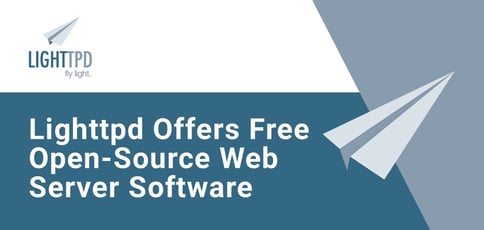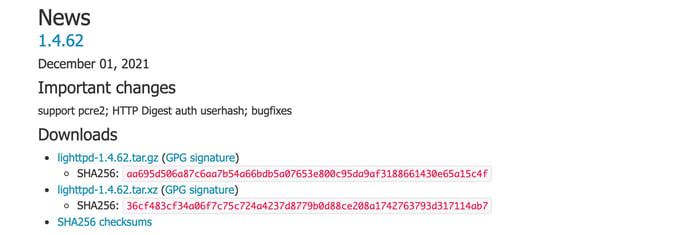
TL; DR: Lighttpd is a secure, fast, and flexible open-source web server software optimized for high-performance environments. The software has a low-memory footprint which promotes efficient management of hardware CPU load. Lighttpd’s advanced feature set makes it a good fit for servers that suffer load problems, and its open-source nature provides SMBs with plenty of flexibility. Lighttpd runs natively on Linux/Unix systems and can also run in Windows environments.
December 2021 marks the 30th anniversary of the launch of the first U.S. web server. Software developer Paul Kunz began using the server at the Stanford Linear Accelerator Center, and his goal was to grant easier and faster access to scientific paper abstracts.
Today, hosted web servers make information accessible anywhere in the world via internet connectivity. Those web servers are now critical foundations of the modern world, responsible for serving everything from digital catalogs and company webpages to blogs and streamed content.
The result of digital ubiquity is that the demand for proprietary commercial web server software solutions has scaled exponentially. As a result, the global web server market now has varying degrees of complexity with stiff competition at each tier.

The open-source web server segment has proved just as competitive, even though the open-source ethos often softens the contention between rival offerings.
One of those contenders is Lighttpd (pronounced Lighty), a free, open-source software solution that rates well in many evaluations of open-source web server contenders.
It often receives mention alongside market leaders, including Apache HTTP Server and Nginx Web Server.
Lighttpd’s dedicated team of open-source experts maintains and supports the software and released version 1.4.63 in December 2021. This version includes updates, such as improved handling of HTTP/2 connections and bug fixes. It is licensed as open-source under the revised BSD license.
“One of Lighttpd’s fundamental goals is to stay small and remain light — hence the shortening of its name to Lighty,” said Lighttpd Developer Glenn Strauss. “It is designed and optimized for high-performance environments, and Lighttpd powers several popular Web 2.0 sites. That’s because its high-speed IO-infrastructure allows them to scale several times better with their existing hosting hardware.”
Built-in Support for PHP, Python, Perl, and Ruby Web Apps
Lighttpd was released in March 2003 by German software engineer Jan Kneschke to address the C10k challenge — which means concurrently handling 10,000 connections. The problem challenged Lighttpd to develop network sockets to handle a large number of clients at the same time.
Kneschke came up with a proof-of-concept web server that was several times faster than the then version developed for Apache HTTP Server and Thttpd, the two main alternative web server options.
One of Lighttpd’s key differentiators is that it’s designed for speed-critical applications and environments. It has a comparatively small software footprint of less than 1MB and is economical with server resources, including CPU utilization. Its users acknowledged it as secure, fast, and it can handle up to 10,000 parallel connections on a single server.
“Lighttpd’s architecture is optimized to handle a large volume of parallel connections, which is crucial for high-performance web applications,” said Glenn. “It supports CGI, FastCGI, and SCGI for interfacing programs with the webserver. Its event-driven architecture is optimized for a large number of connections, which is important for AJAX applications, for instance.”
Lighttpd also supports web applications written in various languages, with special attention given to PHP, Perl, Python, and Ruby. Other features include SSL/TLS support, HTTP compression, virtual hosting, and support for various other modules.
Open-Source Maintainers Meet Diverse User Needs
Visitors to the Lighttpd homepage find a no-frills website designed for the software community and prospective deployers. It features a blog, a support documentation library, forums, and updates on bug issues. Because of its popularity, maintaining and evolving Lighttpd presents Glenn and his tight-knit team with challenges that will sound familiar to software developers in the open-source community.
These include resourcing issues, adding new features, and documentation that meets the open-source community’s high QA expectations.
“You could say that we share the general challenges that face many open-source projects,” said Glenn. “These are mainly to do with resourcing. We are not commercially funded, and commercially funded open-source projects usually mean more driving force behind their development. So fewer people are working on Lighttpd than there are on web servers like Apache or Nginx.”

Yet, the open-source world is no less demanding, and the more successful a software, the higher the volume of community interaction and response.
“Servicing user forum inquiries, for instance, takes up a lot of volunteer time,” Glenn said.
Lighttpd has a donation portal on its website that attracts a steady stream of user contributions.
“Not in the way of formal commercial support, of course, but their donations do help to cover some of Lighttpd’s expenses,” Glenn said.
Easy Set-Up with Support for TLS and Certificate Management
Along with its reduced software size, Lighttpd aims to help users with a speedy setup
“It is easy to get started with Lighttpd,” Glenn said. “To start up a new web server, the minimum configuration file is exactly one line. You can tell Lighttpd to do a whole lot more, of course, but the minimum configuration can be just one line — it’s that simple to get going.”
Lighttpd is very flexible and additional features can be enabled in the configuration. Some features are more complex and require more configuration for integration in each user’s system. Glenn said he finds that developers need to write documentation to explain web systems along with various options for tuning those features for the user’s environment. TLS (Transport Layer Security) and certificate management can be complicated processes, but they are necessary to run a web server properly.

“There are different approaches to achieving a common aim, and there is no one approach that fits all, so we are called upon to help Lighttpd users figure things out,” Glenn said. “ We help them answer questions like, ‘Where am I getting my certificates from?’ and, ‘How am I going to manage my certificates?’ We always strive to make Lighttpd more accessible, through the documentation, to a wider pool of users, including non-professional web managers.”
As an open-source solution, the Lighttpd team also has an extensive and knowledgeable auxiliary resource: the diverse user community.
Feedback Loop Enables Users to Share Knowledge
Lighttpd users contribute directly to the software’s evolution, in the true spirit of the open-source ideal.
“There are many active users out there who do get involved. Close contact with Lighttpd users and the open-source community helps us resolve some issues. But we also host a feedback loop with end users to inform development,” Glenn said. “It’s how we get information back from Lighttpd users about what features could or should be added and to what extent they are must-haves.”
Lighttpd recently added support for HTTP2 and multiple Transport Layer Security (TLS) options, including OpenSSL, LibreSSL, and Network Security Services (NSS).
Lighttpd also aims to increase adoption rates as more businesses enter the market. According to Timelift, adoption of open-source software increased during the COVID-19 pandemic as businesses looked to save time and money while increasing efficiency.
Meanwhile, users will likely determine the evolution of Lighttpd. That’s because the web server software doesn’t need to match the features of its competitors to increase market share. It just needs to work for those who need it.
“The spirit of open-source is essentially one of cooperation,” Glenn said. “There is some competitiveness in play, but not in the sense of putting down other web server players as you might see in the proprietary market. We want open-source in all its manifestations to do well.”
HostingAdvice.com is a free online resource that offers valuable content and comparison services to users. To keep this resource 100% free, we receive compensation from many of the offers listed on the site. Along with key review factors, this compensation may impact how and where products appear across the site (including, for example, the order in which they appear). HostingAdvice.com does not include the entire universe of available offers. Editorial opinions expressed on the site are strictly our own and are not provided, endorsed, or approved by advertisers.
Our site is committed to publishing independent, accurate content guided by strict editorial guidelines. Before articles and reviews are published on our site, they undergo a thorough review process performed by a team of independent editors and subject-matter experts to ensure the content’s accuracy, timeliness, and impartiality. Our editorial team is separate and independent of our site’s advertisers, and the opinions they express on our site are their own. To read more about our team members and their editorial backgrounds, please visit our site’s About page.



